My Favourite Things and the Experience of Subjective Temporality: A Case Study of Rainbow's 'All Night Long'
Marko Aho
Folk Music Institute, Kaustinen, Finland
The seeds for this article were sown more than a decade ago while working in a fish factory in Denmark’s Jutland. One particular experience that took place within the daily work never ceased to intrigue me, and although years passed, this experience, through regular reminiscing, stayed with me in great detail. While occupied in the monotonous work in a fish factory production line, I had the luxury of absorbing myself in unusually concentrated reflection on something special that was a part of passing the time through the “inner jukebox”; that is, previously heard music in one’s musical memory. I was able to take note of something that had always been present in my musical inner listening, which I had previously not reflected upon: namely that listening to music in the musical imagination does not follow the linearity of the original music faithfully, but instead is subject to much alteration in the context of duration and order.Imagining music in the ‘mind’s ear’ is common to most people, but given the obvious difficulties inherent in musical imagery research, comparatively little work has been done on the subject (see Godøy and Jørgensen 2001; Bailes 2007a, 556). Occasionally treated as a negative phenomenon, like an ‘ear-worm’ stuck in one’s head (See for example Liikkanen 2008), musical imagery may also take a voluntary form so that musical images can be drawn upon whenever desired. In a study made by Bailes (2007a) test subjects were checked at random times for musical imagery. Participants reported hearing music for 32% of these random checks. In a study by Levitin (1994) the test subjects reported that they had no trouble imagining the songs, hearing them as if they were actually playing in their heads. Most people can imagine a song in different keys without changing the speed of the song. It is also possible to scan a song at various rates without altering the pitch, as well as imagining a song being played loud or soft, entering the left ear or right ear, being performed inside or outside a large church, as well as imagining the melody being transported by various instruments (Levitin 1999). The imagination can do many things with music, and one of the most interesting things is to alter musical time.
As music is played or imagined, it always exists in relation to the lapsing of time. Music evanesces in time, literally dying as it is born, and through it “people are encompassed and touched by a world that is constantly in process and dynamic, a world that only exists while it is being articulated through sound” (Shepherd & Wicke 1997, 126). In some sense the listening of sound is a direct perception of the running of time, and this makes music, as Victor Zuckerkandl puts it, “temporal art in the special sense that in it time reveals itself to the experience” (Zuckerkandl 1973 [1956], 200).
Edmund Husserl’s (1859-1938) examination of phenomenological time consciousness, subjective time and the experiencing of it, provides us with apt tools for the analytical treatment of subjective temporality of musical imagination. In this article, my aim is to shed light on the internal listening processes within one’s favourite music by carrying out an analysis of a singular case of the temporal experiencing of a favourite song. Husserl developed his views on the consciousness of internal time in dozens of papers during decades of thought, and it is far beyond the scope of this article to provide the reader with a comprehensive presentation of Husserl’s thinking on time consciousness. The time diagrams used in this article were originally made for the lectures of 1904-1905 (Dodd 2005, 111-137). The theme of “living presence” originates, however, from Husserl’s later thinking at the turn of the 1930s (see Held 1966). The translator of the English edition On the phenomenology of the Consciousness of Internal Time [1991] of Zur Phänomenologie des inneren Zeitbewusstseins 1893–1917 [1966], John Barnett Brough, has added to the translation an introduction written by himself (XI-LVII). In this he goes through the relevant features and development of Husserl’s thinking on time consciousness in a popular form. There is also a body of work on music and time written by music phenomenologists. Both Lawrence Ferrera (1991) and Thomas Clifton (1983), two influential writers on the phenomenology of music, presented the lapse of musical time as one key form of musical experience. Judy Lockhead (1989) has applied Husserlian concepts to the analysis of new music: indeed, new music in its lack of traditional syntax lends itself particularly well to analysis, emphasising the listener’s personal sense of form and time. In Joseph F. Smith (1979) and Douglas Bartholomew (1989) one can find a detailed analysis on the formation of the comprehension of a simple melody in human consciousness. Don Ihde starts with the different Husserlian modes of temporality in dealing with the perceiving of sound in general in his Listening and Voice (1976). Particularly the latter three texts have assisted greatly in comprehending the basics of Husserlian thought on inner time consciousness.
Following my introduction to Husserl’s conceptualisation on the issue, I will elaborate on an example, which during my experience at work at the factory, came to the fore. This is the hit song All Night Long by the British 1970s hard-rock band Rainbow. The detailed analysis of my personal “inside-the-head” listening of this particular song will hopefully allow me to draw some general conclusions on how the original music may be temporally altered in one’s musical imagination at the time of reminiscence.
Edmund Husserl and the internal time consciousness
It is customary to divide memory into three conceptual parts, which may or may not have an underlying neural basis: these are the echoic memory, short-term memory and long term-memory. Snyder (2000) associates all these to different levels of musical experience, so that the echoic memory corresponds to “event fusion”, short-term memory to “melodic and rhytmic level” and long-term memory to “formal level”. In the first process of the memory model, echoic memory, the inner ear converts sounds into trains of nerve impulses that represent the frequency and amplitude of individual acoustical vibrations. During the second phase individual acoustical features are extracted from continuous data of echoic memory by special neurons, and then bound together as coherent auditory events. These events are then organised into groupings based into similarity and proximity, and those parts of long-term memory, which have been activated by similar events before, become activated again. (Ibid., 4.) Memory processes are probably functional rather than structural, as it yet needs to be established which distinct anatomical structures of the brain correspond to these particular processes. The memory for musical attributes has its underlying neural basis in qualities we are still in the process of learning more about. But we can obtain another standpoint by turning to the subjectively meaningful experiencing of music’s temporal character, of which the manipulation of music’s temporal linearity in one’s musical imagination may be a highly illustrative example.
Husserl, the father of modern phenomenology, intended his philosophy to be the study of human experience and the ways things present themselves to us in and through such experience. As part of continental philosophy, phenomenology is concerned with, to put it simply, reason’s self-discovery in the presence of intelligible objects; we can evidence the way things are, and when we do so, we do not only discover objects, but also ourselves as those to whom things appear (Sokolowsky 2000, 4-5). Husserl’s analysis of inner time-consciousness is one of his most important and well-known contributions. From the point of view of a music researcher, his analyses in the elaborate study Zur Phänomenologie des innere Zeitbewusstseins 1893–1917 [On the phenomenology of the consciousness of internal time] (Husserl 1991 [1966]) are most interesting, since he exemplifies the time consciousness with music perception. Indeed, sound has a special relationship with the passing of time. Sound literally ceases to exist at the very moment it is born. If sound “stops”, it is there no longer, and we cannot “freeze” a sound for our observation. Temporalness is the way in which music as a special case of sound exists. Thus, when we are listening to music, there seems to be no way in which we can escape the sense of a “coming into being” and a “passing from being” in the motions of sounds. Here temporality is not a matter of “subjectivity” but a matter of the way the phenomenon necessarily presents itself (see also Ihde 1978).
In his analysis, Husserl distinguishes three levels of temporal structure:
1. First, there is objective time: the time of clocks and calendars, the time that belongs to worldly processes and events. This time is public and it can be verified: we can use a clock to measure how long a process takes, and we can agree on the measurement. Objective time can be compared to the spatiality of the world, which we can observe from the outside, object-like. Accordingly, a spatial or visual metaphor, such as an hourglass or a dial of a watch, can be used with objective time.
2. The second level is internal time, or subjective time. This is the experiencing of time: when we have fun time rushes by, but when we are children waiting for Christmas to come time unwinds almost unbearably slowly. Subjective time belongs to the duration and sequence of mental acts and experiences: acts and experiences follow one another, meaning we can also recall certain prior experiences through memory. Internal time can be compared to the way we experience our bodily spatiality ”from the inside”, and it cannot be measured by objective time, similarly as the felt internal distance between different parts of the body cannot be measured with a ruler. Internal time is not something public, only taking place through private experience, the features of which are impossible to visualize with any accuracy.
3. There is also the third level: the consciousness of internal time, which entails the awareness of the level of subjective time. The second level alone is not enough to account for its own self-awareness, and therefore we need a third level to account for what we experience on the second. This third level does not need to be positioned beyond it, but is rather the ultimate context of the experience of time.
In order to be able to comprehend objective time, one needs the sense of subjective time; and for the organization of subjective time, one needs consciousness of this subjective time. One might think that objective time is the most basic, because worldly duration would go on even if we, with our subjectivity, ceased to exist. But if we do not experience a succession of mental activities in our subjective lives, we cannot anticipate and remember objective time as enduring. In everyday thinking, we think of the temporal objects as a series of “nows” presented to us one after another – rather like single still pictures in a motion movie. However, our experience of temporal duration cannot be like this, since all we would have at any given moment would be the frame in the film at any given moment: we would therefore not have a sense of duration. Neither can the sense of duration be based on remembrance, because our recollections would always be “now” moments in our consciousness; for all we would have would be sheer presence without a sense of past. But besides having to posit remembrance of the past, we also have to posit anticipations of the coming, because our experience extends into the future as well as the past. Right in our most elementary experience, we have a sense of past and future directly given.
The sense of time passing underlies all experience and indeed human existence: something has just happened, something is happening right now, and something is about to happen. Whatever we experience, we experience as “going-on”, as passing while it exists. The sense of time requires a sense of its processuality. Because time does not exist as “brought to a standstill,” it can be grasped only as structured: we need a sense of the past, the present and the future. The term the living present refers to the full immediate experience of temporality that we have at any moment: it is the temporal whole at any instant, and consists of three inseparable moments, 1. primal impression (points to the present), retention (points to the past), and 3. protention (points to the future.
The sense of time is a synthesis of these three features. Even a single sustaining sound cannot be conceived without each one of these. Retention retains the living present that has just elapsed. Yet it is not to be confused with remembering: that what is retained has not yet left the consciousness so that it could return there. Remembering is thus a new start, where something that has already left the immediate consciousness is brought back; or to be more precise, remembering brings into memory the representation of the past. Similarly, protention is not for instance imagining oneself in a new situation, but rather a consciousness of the fact that one is advancing in time. Protention seeks follow-up to the present by opening up the very dimension of the future, thus making a fully-fledged anticipation possible.
The elapsed living, which we retain, is itself made up of a primal impression, protention and retention. In fact, in retention we have a full series of elapsed living presents with their retentions, which further include their prior retentions, so that in the living present we have a retention of retentions of retentions. We never have an atomic living present all by itself, but the living present always has a kind of comet’s tail of elapsed living presents. All this may come over as perplexing, but Husserl clarified this process by introducing sound and music to the larger scheme. Diagram 1 consists of a series of “now-moments”, the fading of a sound in retention, a phase of present and recent sounds, and an exemplary tracing of one given point (or note).
Figure 1
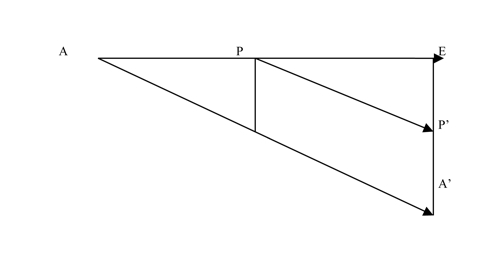
AE = series of “now-points” in sound duration
AA’ = evanescing of the sound
EA’ = phase continuum of present and past sounds
PP’ = tracing of one given point in sound duration
Within the temporal span of the living present it is possible to focus upon either the source-point or the onset of an event or upon the “running off” of it. Three simple examples serve to illustrate the variability of temporal focus. Let us imagine a psychological test, where we are waiting for a “click” informing us to push a button or execute some other simple action: our protending expectation concentrates on the futural edge of the temporal span in order to be prepared for the onset of the click. Conversely, if we are to listen to a tone to identify its position within the musical scale, we do not attend specifically to its instantaneous source-point, but rather pay special attention to its tonal quality that appears even more strongly in its “running off” reverberation.
Figure 2
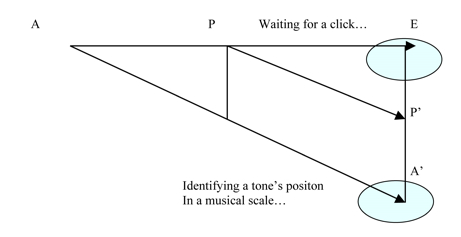
In another example, we can imagine ourselves as a luthier (someone who make or repairs stringed instruments) absorbed in the evaluation of the overall sound of our new guitar. As we pluck the string, we have the attack of the sound, and its sustain and ultimate decay. The attack elapses immediately to retention, and so does every single moment of the tone's sustain. The sounding continues, and as it does, it may change; at the very least it becomes quieter each moment. In our evaluation, our attention focuses equally on what we hear at each moment and what the sound was like from the moment of our plucking the string: primal impression, retention and protention are in balance.
Each of the three cases above serve to illustrate how the capacity of focusing within the living present is of extreme importance to our acquaintance with auditory phenomena. In the realm of human experience, music seems to be something special in that it seems to dramatically reveal something about the character of the internal sense of time. It might have been for just this reason that Husserl (1991 [1966]) had the impetus to use melody as an illustrative case of how consciousness grasps the running of time.
When a given musical entity, song, work for example has been learnt by heart, it may return into the consciousness by just one of its fragments. Recollecting some experience is different from the original experience. In the original experience the “running off” of music is somewhat prescribed, whereas recollection is a freer going-through of some entity: we can execute the representation either more quickly or more slowly; explicitly or ambiguously; as a lightning-fast hit or by degrees.
However, the recollective process does merely renew these protentions memorably. They are not only there in the process of catching what is coming; they have also caught it. They have been fulfilled, and we are conscious of this in the recollection. The fulfilment in the recollective consciousness is re-fulfilment (Husserl 1991 [1966], 54).
‘All Night Long’ – personal recollections
In the analysis that will now follow, I will go through my personal recollections of “internal listening” of a particular favourite pop-song. The song in question is ‘All Night Long’ by the seventies British hard rock band Rainbow (Rainbow 1979). The song was recorded in 1979 and included in the successful album Down to Earth, which also included the hit-to-become-rock-anthem ‘Since You’ve Been Gone’. I was probably first introduced to ‘All Night Long’ through radio or TV. They might have played the songs in discos, and they might have been there also as background music on certain social occasions. Ultimately, I was able to borrow the album from a friend of mine for a few weeks in summer 1990, during which time I listened to these two songs to the extent that - if asked - I would have claimed to remember every detail of them. In summer 1993, while working at the production line as a factory worker, these two songs which I very much loved were distinctly present in my “internal jukebox,” through which I used to entertain myself during the hours at work. As the work was monotonous and required no special mental effort, I somehow became absorbed with taking notice of how exactly I listened to the songs. At the time, and during the years to come, I have constantly found myself contemplating the way these two aforementioned songs were modified in my internal listening in comparison to the original recordings (in order to not to ruin my internal version of the song, I never acquired the album until the making of this study). While the features of ‘All Night Long’ and my intentional habits in listening to it may almost certainly have been further modified in my mind during the decade and a half since my original experience, the parameters of the modification nevertheless remained constant. I have identified the means of temporal modification as:
a) looping of short passages, where one can be repeated indefinitely;
b) augmentations or “gourmandisings” as one indulges oneself in a particularly delicious moment in the flux of music, such as cadenzas or individual sounds, and lets them “ring” in one’s head for a duration;
c) reductions, where unimportant moments are omitted from a passage;
d) the merging of separate features from separate points in the original performance, such as combining several moments in the vocal part to form an “absolute” vocal passage;
e) preparation, where a “highpoint” often becomes such only against some background.
I will now illustrate these possibilities of modification with details from my internal listening of the song ‘All Night Long’. These particular examples are intended to demonstrate the kind of temporal processes that come into force during the listening of one’s favourite music. In order to illustrate this, I have used notation examples as well as heavily modified music extracts. Both the notation and the modified music examples provide ways of representing the real experiences, although they significantly distort the “real thing”. They function as metaphors to convey the idea. Since internal listening does not follow the linear logic of objective time, it is ultimately impossible to create accurate audio or visual representations of it. Chart 1 represents the whole song in its original form, in which the details to be taken into closer study are marked.
Chart 1: Analysis of 'All Night Long'
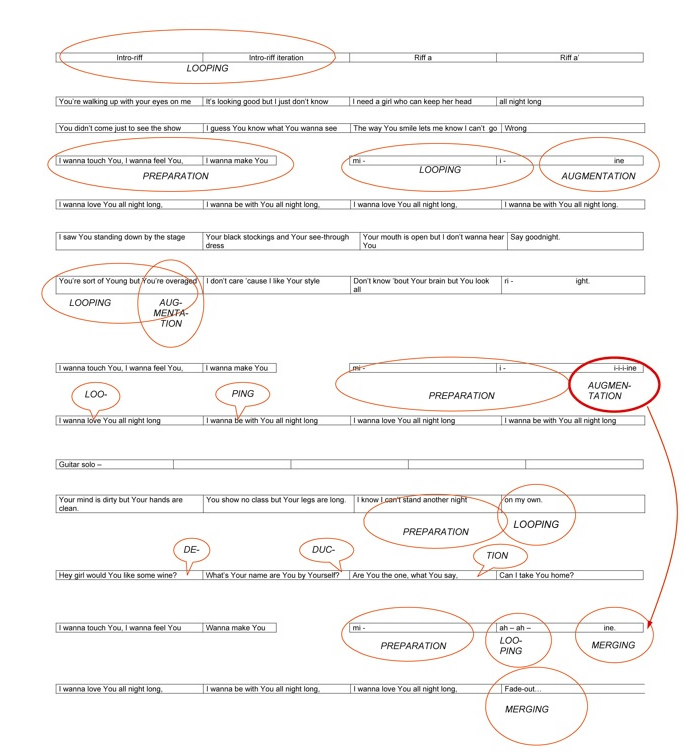
Example 1.
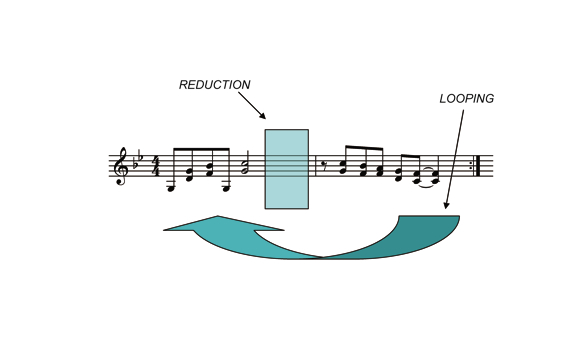
In Example 1, we find the famous opening guitar riff of the song. I greatly liked to loop this sequence in order to reiterate it several times, often reducing some length from the double-stop half-note of the first bar. This perfect fourth (g – c), however, remains present in its full measure even when after its duration has been “shortened”.
Example 2.
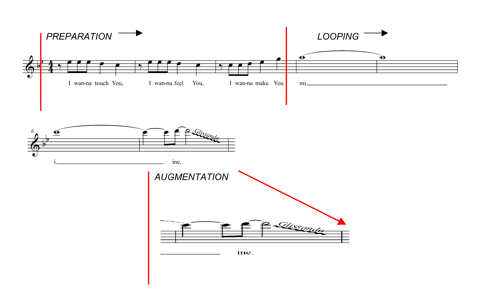
In Example 2 we have the ending of the first chorus. The climax of the chorus requires some preparation or context in the internal listening for its full effect. The climax, which I often reiterated several times, had in it a “climax of a climax”. This was found in the final bellow of the singer Graham Bonnet, a particularly satisfying moment, which in my internal recollection was especially enjoyed and temporally “held back”.
Example 3.
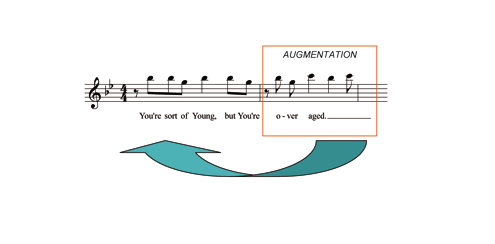
In the next chorus, again, an especially pleasurable phrase by the singer would be reiterated again and again, with a climaxing bellow of the lead singer to indulge in, for a mental duration slightly longer than the original.
Example 4.
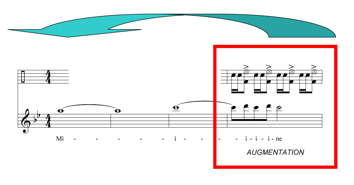
In Example 4 the climax of a verse occured, now with an additional twist. At the end of this passage we have the high point of the vocal performance of the whole song, an undulating vocal eruption. This high point is underlined by a powerful drum-fill, during which the drums rise from the background for a brief moment. This last measure was for me the climax of the song, and would become reiterated endlessly in my internal recollecting. The memory of this moment would become somewhat varied in my musical imagination, and it would sometimes be realized there accompanied by the drum fill, sometimes alone, and sometimes in turns with the drum fill.
Example 5.

The top tones of the vocal performance of the chorus stood out in the original recording in their rough quality, and became reiterated in my recollection sessions.
Example 6.

The imposingly sung phrase on my own which became reiterated required the previous phrase as a preparation for the full effect at the moment of recollection.
Example 7.
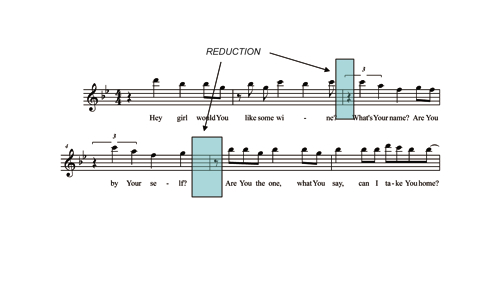
This short passage appealed to me with because of its candid lyrics. The lyrics needed to be listened to in their full measure, but I deducted the “empty spaces” between the phrases for their unimportance as I listened to the passage in my head.
Example 8.
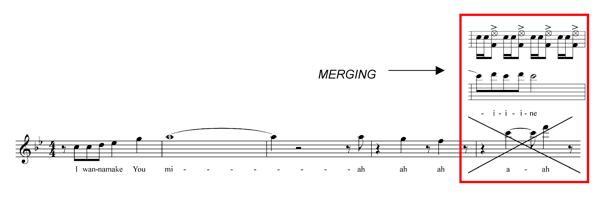
The end of the last verse and the climax of the whole song (see Example 4) work together to an even greater effect than the merged climax of the song alone. In subjective listening it is easy to combine the best of both worlds.
Example 9.
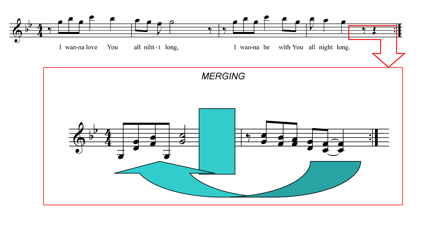
In the recording, the song fades out. I always felt that the song should end with the guitar riff that begins the song.
The human mind – an ultimate Walkman?
During this process I discovered that the internal listening of familiar favourite music did not seem to adhere strictly to the linear and objective temporal order; on the contrary, by way of protention and retention, by orienting oneself to the “running off” of music or to its “following up” for the present, music in the musical imagination could be temporally modulated to suit my exact preferences. This means that I could listen to the best moments of this favourite song of mine, in my musical imagination, quite non-linearly: unessential parts of music could be left out and pleasant moments reiterated. This happened quite inconsistently verifying Levitin’s claim that different sections of songs seem to carry “flags” or “markers” that act as starting points, which, to some extent, are idiosyncratic, depending on what parts of a song are salient and how well one knows the song (Levitin 1999). The most interesting feature of the process of my internal listening was that the most satisfactory high points could be extended beyond their objective proportion. The elaborated case study of a particular listening experience served to exemplify the different ways of internal temporal organisation of music.
After carrying out an experiment on imagining music in the everyday lives of music students, Bailes (2007a) was able to note that, on the whole, respondents were quite aware of the music they imagined (though not concentrating particularly on the music). It seemed that very often the repeated segment was the chorus of a song rather than a full mental run-through. Different musical dimensions were imaged to a different extent, with melody and song lyrics the most vivid, and timbre, harmony and expression the least vivid. Especially timbre proved to be an elusive component of imagery for music. Another experiment (Bailes 2007b) showed clear difficulties in the intentional imaging of music in laboratory experiments. However, it is noteworthy that the respondents in that study clearly stated that they would have found the use of acoustic rather than sampled sounds an advantage, and that recognition of the instrument was deemed important to image formation (some participants explained that they would tend to visualise an instrument or instrumentalist when imaging a timbre). In an experiment explicating how well test subjects were able to remember the absolute pitches of familiar pop-songs, Levitin (1994) achieved results which prompted him to put forward the idea that one’s internal representation of a song that one is repeatedly exposed to, may well represent the whole spectro-temporal pattern of that song.
These findings are in full accordance with the ones I achieved in my experiment. Comparing the synthetic subjective “in the head” listening to the linear mode of listening to music, several discrepancies arose. One feature of internal listening - which is partly linked to subjective temporal modification, partly to other aspects of musical imagination - is that while I might not have been able to remember the song lyrics all that well and the exact details of the instrumental arrangement, I still heard the vocals and accompaniment in my mind in no way inferior when it came to timbre or any other dimension. Strictly to the domain of the temporal belong the phenomenon that even though I omitted moments from the middle of a sequence, the ongoing rhythm was not interrupted in a disturbing way, such as it does when a procedure is carried out on a sound recording. Ultimately the internal temporally modulated experience, the subjective time of music, cannot be mediated: if I make, with the aid of computer and some audio software, modified audio examples of the music examples presented above, I will be returning to objective time. If I indulge in an especially satisfying moment of music in my head, let it ring in my internal “ear”, but in objective time, maybe less time passes than it takes in the original sound for that particular moment to pass. Augmentation as an internal act is not commensurable with phenomena in objective time. When such augmentation is carried out artificially in real time, the end product does not correlate much with an internal sense of augmentation: the computer merely slows down, but the musical imagination prolongs and augments. Similarly, a linear compilation of the modified music examples presented above would not resemble the subjective experience of the song, not even in the sense that the totality of the song is still the whole song I used to hear originally as a recording. Even though I may not return in my internal listening to all parts of the song, the whole song is still there as a background against which the excerpts of my preference become such.
It is important to note that there are naturally many different modes even for internal listening, and the subjective temporal modulation may not often be that pronounced. It may well be that, for example, a composer working on a new piece may be inclined to follow the objective temporal order also in one’s musical imagination, for the sake of being able to explicate the creation in traditional means. Also, spontaneous and subtle subjective temporal modulation most probably often goes totally unnoticed. However, the implication to music analysis of subjective temporality and its role in music listening is that of focusing on the objective; linear progression of music may not do full justice to real musical experiences in situations where music does not exist as an external input, but only as a sound in our internal musical imagination.
[1] The first two examples are given in Ihde (1978).
References
Bailes, Freya. 2007a, The Prevalence and Nature of Imagined Music in the Everyday Lives of Music Students. Psychology of Music 4: 555-570.
Bailes, Freya, 2007b. Timbre as an Elusive Component of Imagery for Music. Empirical Musicology Review 1: 21-34.
Bartholomew, Douglas. 1989. Preamble to a Phenomenology of Music. Ed. Joseph F. Smith. Understanding the Musical Experience. Montreux: Gordon and Breach.
Clifton, Thomas. 1983. Music as Heard: a Study in Applied Phenomenology. New Haven: Yale University Press.
Dodd, James. 2005. Reading Husserl’s Time Diagrams from 1917/18. Husserl Studies 2: 113-137.
Ferrara, Lawrence. 1991. Philosophy and the Analysis of Music: Bridges to Musical Sound, Form and Reference. Westport: Greenwood Press.
Godøy, R. I. and Jørgensen, H., eds. 2001. Musical Imagery. Lisse: Swets & Zeitlinger Publishers.
Held, Klaus. 1966. Lebendige gegenwart. Die Frage nach der Seinsweise des transzendentalen Ich bei E. Husserl, entwickelt am Leitfaden der Zeitproblematik. Den Haag: M. Nijhoff.
Levitin, Daniel J. 1994. Absolute Memory for Musical Pitch: Evidence from the Production of Learned Melodies. Perception & Psychophysics 4: 414-423.
Husserl, Edmund. 1991. On the phenomenology of the Consciousness of Internal Time. Dordrecht : Kluwer.
Ihde, Don. 1978. Listening and Voice: Aphenomenology of Sound. Athens, Ohio: Ohio University Press.
Levitin, Daniel J., 1999. Memory for Musical Attributes. Ed. Cook, P.R. Music, Cognition and Computerized Sound: An Introduction to Psychoacoustics. Cambridge: M.I.T. Press.
Liikkanen, Lassi A., 2008. Music in Everymind: Commonality of Involuntary Musical Imagery. Proceedings of the 10th Internationla Conference on Music Perception and Cognition. Eds. Miyazaki, K., Hiraga, Y., Adachi, M., Nakajima, Y., and Tsuzaki, M. Sapporo.
Lockhead, Judy. 1982. The Temporal Structure of Recent Music: a Phenomenological Investigation. Stony Brook: SUNY.
Shepherd, John, and Wicke, Peter.1997. Music and Cultural Theory. Cambridge: Polity Press.
Snyder, Bob. 2000. Music and Memory. An Introduction. Cambridge: MIT Press.
Smith, F. Joseph. 1979. The Experiencing of Musical Sound: Prelude to a Phenomenology of Music. New York: Gordon and Breach.
Sokolowski, Robert. 2000. Introduction to Phenomenology. Cambridge: Cambridge University Press, 2000.
Zuckerkandl, Victor 1965 [1973]. Sound and Symbol. Music and the External World. Princeton: Princeton University Press.
Discography
Rainbow, 1979. Down to Earth. Polydor Records 547 364-2.

